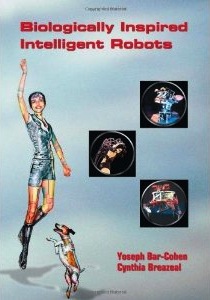Dr. Breazeal is an Associate Professor of Media Arts & Sciences at the MIT Media Lab and is the founder and director of the Personal Robots Group. Her background is in electrical and computer engineering as well as computer science. Her unique contributions to the field of biomechanics are related to human robot interaction. Breazeal’s bio explains:
Her research focuses on developing the principles, techniques, and technologies for personal robots that are socially intelligent, interact and communicate with people in human-centric terms, work with humans as peers, and learn from people as an apprentice.
Breazeal’s work incorporates the biomechanics of human interactions in robotic form. The hardware and software systems she and her group build aim to create natural, comfortable, socially appropriate interactions between humans and robots through these robots’ motions, posture, and facial expressions — behavioral biomimetics might be an appropriate term here. A related direction to this work is Breazeal’s interest in building robots able to recognize and mimic human actions as training for task completion (instructing robots through demonstration rather than programming).
Publications
Dr. Breazeal has over 100 publications to her credit including three books. Of perhaps greatest interest to those in the field of biomechanics is the book she edited entitled Biologically Inspired Intelligent Robots.
From the book’s summary:
“Advances in biologically-inspired technologies, such as artificial intelligence and artificial muscles, are making the possibility of engineering robots that look and behave like humans a closer reality. The multidisciplinary issues involved in the development of these robots include materials, actuators, sensors, structures, functionality, control, intelligence, and autonomy. This book reviews various aspects ranging from the biological model to the vision for the future.”
Selected Projects
Cog
As a graduate student, Breazeal worked with Dr. Rodney Brooks at the MIT Artificial Intelligence Lab. The robot Cog was a project of Brooks’ Humanoid Robotics Group in the late 1990s and early 2000s. Breazeal was Cog’s chief architect. The impetus for Cog was to explore intelligence as an embodied phenomenon. That is, Cog’s AI systems were to learn by doing and experiencing the world physically as we humans do — akin to human babies.
Cog was built with the biomechanics and sensory abilities of a human torso. For instance, its visual system simultaneously incorporated wide-angle and fine focus video as well as replicated our saccades (the rapid movement of the human eye between precise fixation points). Cog’s limbs were built to respond with the elasticity of human joints and connective tissues rather than the rigidness of a traditional industrial robotic arm.
Breazeal’s experiences with Cog inspired her future direction.
The following video gives a good introduction to Cog (note: Breazeal does not make an appearance in this particular video).
Nexi
In more recent years, Breazeal’s attention has turned to social robotics. Nexi is an instance of Breazeal’s group’s Mobile/Dexterous/Social project. Nexi’s dexterity moderately approximates that of human arms and hands (a great improvement over Cog). Nexi’s neck, head, and face were specifically designed to recreate human facial expressions and posture and to do so with the speed of the human musculoskeletal system.
As an example of Nexi’s abilities, she has been used to study human trust in relation to social cues [see video accompanying article]. In conversation with human study participants, Nexi was used to reliably repeat facial and posture cues thought to be related to deception — even the best human actors could not hope to do so sufficiently for controlled studies. After interacting with Nexi, study participants played a variation of the classic prisoner’s dilemma game including a financial reward; their decisions in this game would be primed by the level of trustworthiness Nexi expressed and measured in terms of bets placed.
The following video shows a demonstration of Nexi’s dexterity and emotive expressiveness.

